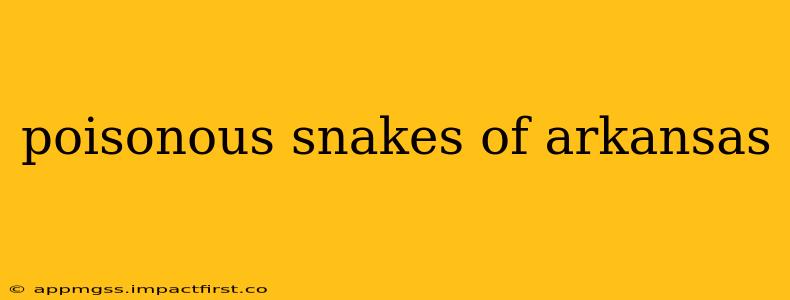Arkansas, with its diverse ecosystems ranging from the Ozark Mountains to the Mississippi Alluvial Plain, harbors a variety of snake species. While many are harmless, some are venomous and pose a potential threat. Understanding which snakes are poisonous (a more common term than "venomous" for the general public) and how to identify them is crucial for safety. This guide provides a comprehensive overview of the poisonous snakes found in Arkansas, emphasizing identification, behavior, and safety precautions.
What are the Poisonous Snakes in Arkansas?
Arkansas is home to several venomous snake species, all belonging to the pit viper family (Crotalidae) or the elapid family (Elapidae). The most commonly encountered poisonous snakes in Arkansas are:
- Copperheads ( Agkistrodon contortrix): These snakes are relatively common throughout the state and are known for their distinctive copper-colored heads and hourglass-shaped markings on their backs. They are ambush predators and usually only bite when threatened.
- Cottonmouths/Water Moccasins (Agkistrodon piscivorus): As their name suggests, these snakes are frequently found near water sources. They possess a broad, dark-colored head and a distinctive dark band along their mouth. Cottonmouths are more aggressive than copperheads and will often display defensive behavior, including gaping their mouths to reveal the white lining (hence the name).
- Timber Rattlesnakes (Crotalus horridus): These are large, robust snakes with a characteristic rattle at the end of their tail. They are usually found in rocky, wooded areas and are generally less aggressive than cottonmouths but their venom is potent.
- Pigmy Rattlesnakes (Sistrurus miliarius): Smaller than timber rattlesnakes, these snakes still possess a rattle, though it's often less distinct. Their coloration varies, making identification sometimes challenging.
Are there any other venomous snakes in Arkansas?
While the above four are the most prevalent poisonous snakes in Arkansas, other venomous snakes might occasionally be found. These are typically less common and might represent rarer occurrences or migrations from neighboring states. It's always best to err on the side of caution and avoid handling any unfamiliar snake.
How can I identify a poisonous snake in Arkansas?
Identifying a snake correctly requires careful observation. While there are general characteristics associated with poisonous snakes, it’s not always foolproof. Never get too close to try and identify a snake you believe is poisonous. Remember, the best way to avoid a snakebite is to avoid snakes entirely.
Here are some general characteristics to consider (but remember, exceptions exist!):
- Triangular head: Many venomous snakes have a triangular or heart-shaped head, distinct from the more elongated head of non-venomous snakes.
- Heat-sensing pits: Pit vipers (copperheads, cottonmouths, and rattlesnakes) have heat-sensing pits between their eyes and nostrils. These pits help them detect warm-blooded prey.
- Vertical pupils: Many venomous snakes have vertical pupils, similar to a cat’s eyes. However, some non-venomous snakes also share this characteristic.
- Rattles (for rattlesnakes): The presence of a rattle is a definitive sign of a rattlesnake.
What should I do if I see a poisonous snake?
- Give it space: The most important thing is to maintain a safe distance and avoid any confrontation.
- Do not attempt to kill it: Killing a snake can be dangerous and is often unnecessary. Snakes play a crucial role in the ecosystem.
- Keep children and pets away: Warn others in the vicinity to keep a safe distance.
- Call animal control or a wildlife professional: If you're concerned about a snake near your home or if you believe it poses a danger, contact animal control or a wildlife removal service.
What should I do if I'm bitten by a poisonous snake?
A snakebite is a medical emergency. Follow these steps:
- Remain calm: Panic can worsen the situation.
- Call emergency services immediately: Dial 911 for immediate medical assistance.
- Keep the bitten area below heart level: This can help slow the spread of venom.
- Remove any jewelry or tight clothing: Swelling can occur rapidly.
- Do NOT: attempt to suck out the venom, apply a tourniquet, or use any home remedies. These actions can be harmful and ineffective.
What is the treatment for a venomous snakebite?
Treatment for a venomous snakebite involves antivenom administered by a medical professional. The specific type of antivenom will depend on the species of snake involved. Getting immediate medical attention is crucial for the best outcome.
This guide provides a general overview of poisonous snakes in Arkansas. For more detailed information, contact your local wildlife agency or a herpetologist specializing in Arkansas snakes. Remember, responsible observation and respect for wildlife are crucial for ensuring the safety of both humans and animals.
